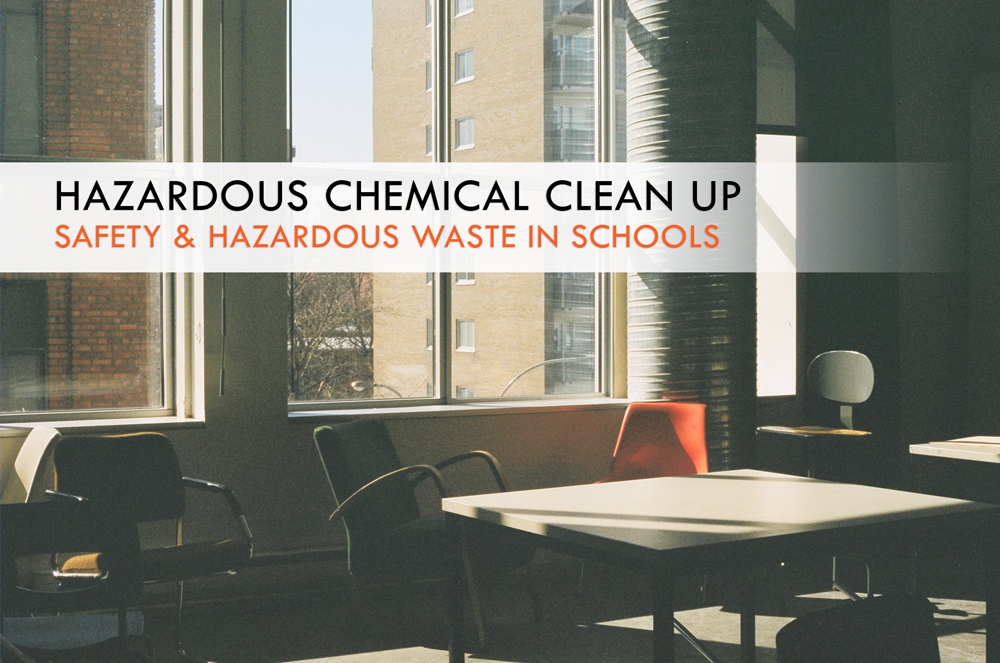Interview: Safely Managing Hazardous Waste in Schools
Published November 2015

For as long as students have been in schools, the methods and tools of teaching have evolved and changed. Today we’re sharing a short interview with a small school district that came up against a confusing, and potentially dangerous set of chemicals in their science labs that needed to go. The chemicals had eclipsed their classroom usefulness, and while they had been sitting idly on a shelf for some time the threat of their presence was real. The story is not unique, but not many clients we’ve worked with are willing to share. We’re lucky to have this insight from a small district in South Dakota and hope it helps you.
If you’re not interested in the interview, skip right ahead to get the Hazardous Waste Inventory Kit now and you’ll receive:
- A two page users guide to accurately inventory waste
- MSDS (Material Safety Data Sheet) Quick Facts
- 3 ways to Find MSDS Sheets you need
Roxanne is the Business Manager for a small school district in South Dakota. Her job includes a wide range of responsibilities, which is something many of us are familiar with these days. Many times in our jobs, we are asked to make decisions, buy products, or hire vendors outside our personal scopes of expertise. Roxanne tells us more about their chemical waste disposal project, and how she found and decided to work with TRC. We also interview one of the TRC service techs about safely managing hazardous waste.
TRC: What was the nature of your project? Why did you hire TRC?
Roxanne: We had several old chemicals that needed disposal. Our school liability insurance carrier had instructed us (after an inspection) that the old chemicals would pose a liability issue to the school if anything should happen, like an explosion or fire. During the project, your tech discovered a chemical TRC could not dispose of. It was a very old chemical used in making bombs. [Editor: TRC does not handle explosive, radioactive, or bio-hazardous wastes.] The tech instructed us on who to contact and how it would be taken care of. We contacted the Sioux Falls, South Dakota, bomb squad and they set up a date to come down and dispose of the chemical.
TRC: How did you hear about us and what made you select TRC as a vendor for your project?
Roxanne: I spoke with your representative at a South Dakota Association of School Business Officials conference in Pierre, South Dakota. When we realized the need for this project TRC was the only vendor I had for this type of service.
TRC: Did you feel that TRC did a good job with project management, your budget, and helping you understand the process changes when the unexpected chemicals were found?
Roxanne: We are 100% satisfied with the service provided by TRC. We have received all the necessary documentation needed to show our liability insurance company that the volatile chemicals were removed from the school and disposed of correctly. The project was completed on time. We were quoted a price and were billed for the exact quoted amount.
TRC: What is the primary benefit you have experienced by using TRC as your service provider?
Roxanne: After the TRC disposal visit, we are confident that the remaining chemicals we have are safe for the school environment. We were contacted several times before the visit (to set up the date and time of visit) and several times after the disposal date (to check on our satisfaction and to check on the remaining chemical that was to be disposed of by the bomb squad of Sioux Falls).
TRC: Thanks, Roxanne. We really appreciate you sharing your story with us!
That sounds like a pretty serious set of chemicals that Roxanne was dealing with, so we decided to talk directly to the TRC tech, Nick. He took care of the lab packing on site for this hazardous waste recycling project.
TRC: What was the chemical that you found in the school? And why were you unaware of it before you came to do the lab pack?
Nick: They had solid benzoyl peroxide. We usually see organic peroxides in solution instead of as a solid.
TRC: How often do you find chemicals like this, are they really common? Where are they likely to be hiding out?
Nick: Organic peroxides are fairly common, but the vast majority of them are not explosive when they are initially purchased. More often when we come across explosive peroxides, they are materials that have been kept well past their expiration date and have become explosive over time. Cream hardeners for automotive body repair, ethyl ether, tetrahydrofuran, and picric acid are a few of the most commonly found items.
TRC: What is the best first step you would recommend to anyone trying to safely manage hazardous wastes or get a clean-up in motion?
Nick: For ongoing waste management it is important to be aware of what you have in your facility. Keeping a live inventory of chemicals and their expiration dates will help to ensure that chemicals are disposed of in a timely manner once they are no longer usable. Also, labeling of secondary containers is very important. Disposal of unknown chemicals is always a scary proposition, and for the most part it can easily be avoided by simply labeling containers. Finally, if you already have a large stockpile of chemicals that you no longer need, act quickly. Unfortunately, proper disposal of chemical wastes rarely gets cheaper over time and the risk of spills, reactions, and complications grows the longer you sit on them.
TRC: Thanks, Nick!
Are you dealing with a unique waste situation, or curious what it will take to clean up at your facility. Contact TRC today to talk to one of our environmental services specialists.